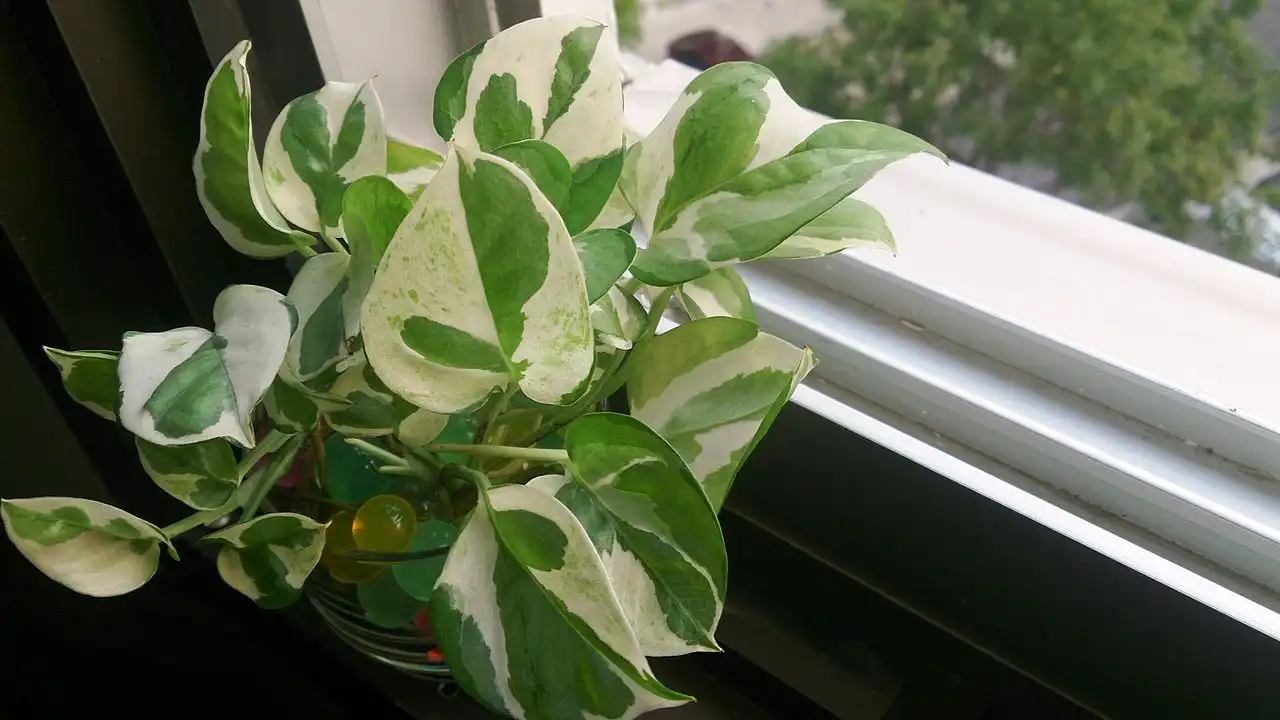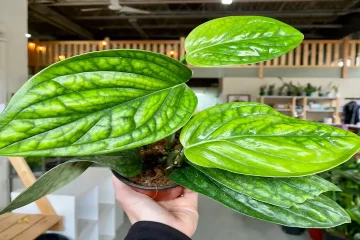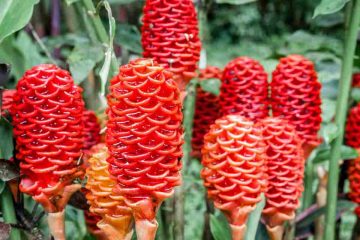Manjula Pothos, a stunning variegated variety of Epipremnum aureum, captivates plant enthusiasts with its heart-shaped leaves featuring white, cream, and green marbling. Renowned for its air-purifying qualities, this tropical vine is an excellent choice for both novice and experienced gardeners. Originating from the rainforests of Southeast Asia, Manjula Pothos thrives in a variety of indoor environments, making it a versatile and low-maintenance houseplant similar to Dipladenia. With proper care, this beautiful plant can flourish and become a focal point in any indoor space. This guide will cover essential aspects of growing, caring for, propagating, and understanding the benefits and common pests and diseases of Manjula Pothos.
| Common Name | Manjula pothos |
| Botanical Name | Epipremnum aureum ‘Manjula’ |
| Family | Araceae |
| Plant Type | Vine, perennial |
| Mature Size | 1-10 ft. long, 1-4 ft. wide |
| Sun Exposure | Partial |
| Soil Type | Moist but well-drained |
| Soil pH | Acidic |
| Hardiness Zones | 10-12 (USDA) |
| Native Area | Cultivar, no native range |
| Toxicity | Toxic to people, pets |
How to Grow & Care for Manjula Pothos?
Following are the growing and caring methods for Manjula Pothos:
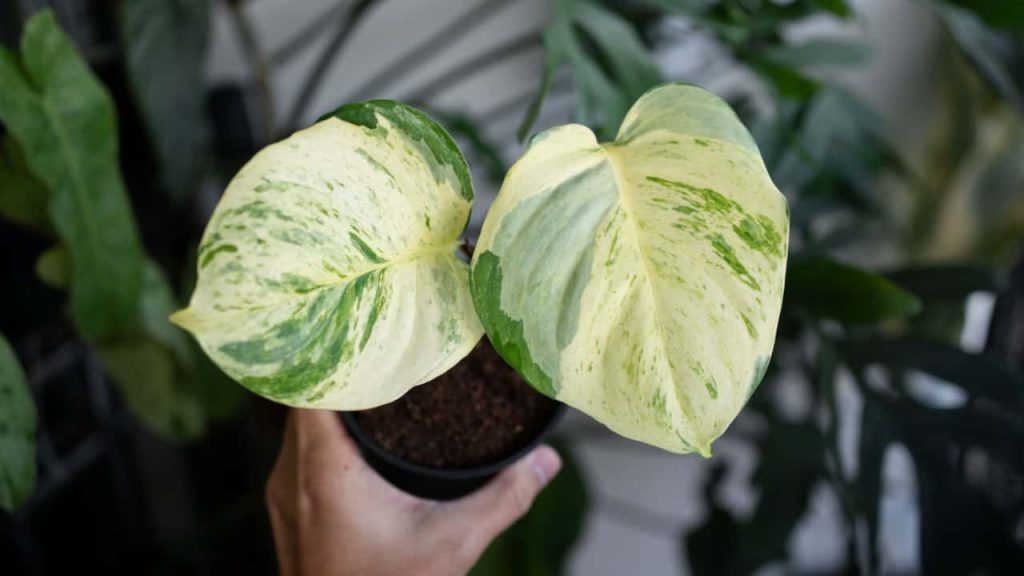
Choosing the Right Location
Manjula Pothos thrives in bright, indirect light but can tolerate low light conditions. Avoid direct sunlight as it can scorch the leaves. Place your plant near a north or east-facing window, or provide filtered light through sheer curtains. If your space lacks natural light, consider using a grow light to ensure your Pothos gets the light it needs to flourish. Consistent lighting helps maintain the vibrant variegation and promotes healthy growth. Remember, the right location is crucial for the overall health and aesthetic appeal of your Manjula Pothos.
Ideal Soil Conditions
Manjula Pothos prefers well-draining soil to prevent root rot. Use a high-quality potting mix designed for indoor plants or make your own by combining equal parts of peat moss, perlite, and pine bark. This mix ensures good aeration and proper drainage. Avoid using heavy garden soil, which can retain too much moisture. Regularly check the soil’s moisture level and water only when the top inch feels dry. Proper soil conditions are vital for the root health and growth of your Manjula Pothos, contributing to its overall vitality and longevity.
Proper Watering Techniques
Watering Manjula Pothos correctly is essential for its health. Allow the top inch of soil to dry out between waterings. Overwatering can lead to root rot, while underwatering can cause the leaves to wilt. Use room temperature water and water thoroughly until it drains out of the bottom of the pot. Discard any excess water in the saucer to prevent waterlogging. During winter, reduce the watering frequency as the plant’s growth slows down. Monitoring the soil moisture and adjusting your watering routine accordingly ensures your Manjula Pothos remains lush and vibrant.
Temperature and Humidity Requirements
Manjula Pothos thrives in temperatures between 60-85°F (15-29°C). Protect it from drafts, sudden temperature changes, and cold temperatures below 50°F (10°C). This tropical plant also prefers high humidity levels, ideally between 50-70%. Increase humidity by placing a humidifier nearby, misting the leaves regularly, or using a pebble tray filled with water. Grouping plants together can also boost the humidity. Maintaining optimal temperature and humidity conditions helps your Manjula Pothos grow vigorously and prevents stress-related issues, ensuring a healthy and attractive plant like Bachelor Buttons looks very unique and different..
Fertilizing Your Manjula Pothos
Regular fertilization promotes healthy growth in Manjula Pothos. Use a balanced, water-soluble fertilizer diluted to half strength every 4-6 weeks during the growing season (spring and summer). Avoid over-fertilizing, which can cause salt buildup and damage the roots. In fall and winter, reduce the frequency to once every 2-3 months as the plant’s growth slows. Organic options like fish emulsion or compost tea can also provide nutrients without the risk of over-fertilization. Consistent, moderate feeding ensures your Manjula Pothos remains vigorous and maintains its striking variegation.
Pruning and Maintenance
Regular pruning helps maintain the shape and encourages bushier growth in Manjula Pothos. Trim long, leggy vines back to promote branching and remove any yellow or damaged leaves. Use sharp, clean scissors or pruning shears to make clean cuts just above a leaf node. Pruning also helps control the plant’s size and prevents it from becoming too unruly. Additionally, wipe the leaves with a damp cloth to remove dust and keep the plant looking fresh. Proper pruning and maintenance ensure your Manjula Pothos remains healthy, attractive, and well-shaped.
Repotting Manjula Pothos
Repotting Manjula Pothos every 1-2 years helps accommodate its growing root system. Choose a pot that is 1-2 inches larger in diameter than the current one, with drainage holes. Gently remove the plant from its old pot, loosen the root ball, and trim any dead or rotten roots. Place the plant in the new pot with fresh potting mix, ensuring the roots are well-covered. Water thoroughly after repotting to settle the soil. Repotting provides more space for root growth and refreshes the soil, promoting the overall health and growth of your Manjula Pothos.
How to Propagate Manjula Pothos?
Below are the methods of propagating for Manjula Pothos:
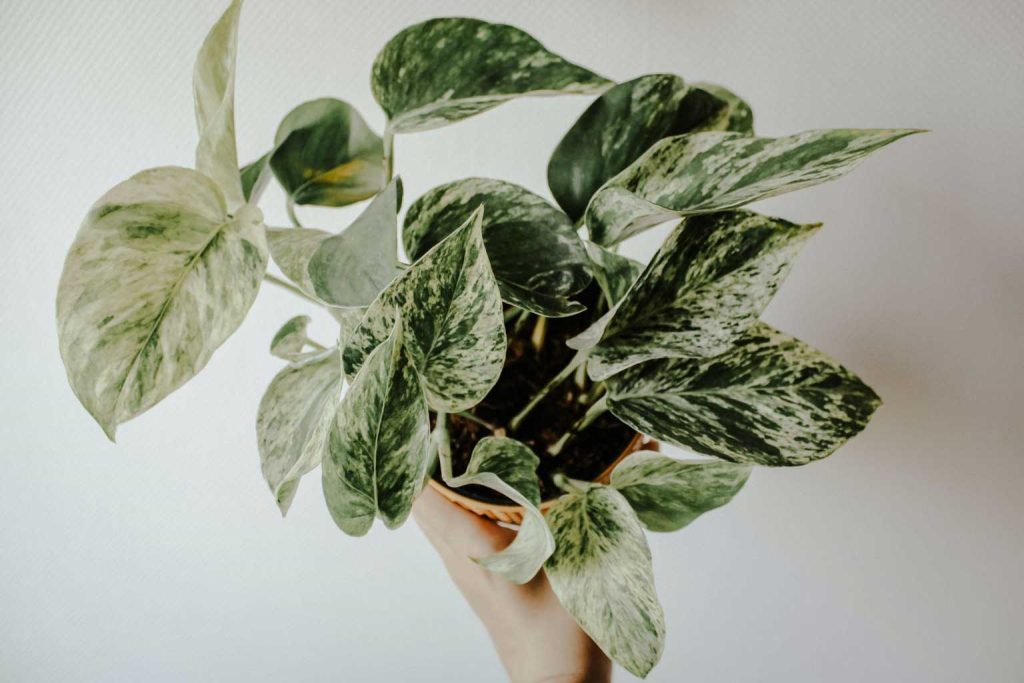
Propagating Manjula Pothos is a straightforward process that can be done through stem cuttings. Here’s a step-by-step guide to help you propagate your Manjula Pothos:
Materials Needed
- Healthy Manjula Pothos plant
- Clean, sharp scissors or pruning shears
- Small pots with drainage holes
- Potting mix (well-draining)
- Water
- Rooting hormone (optional)
- Clear plastic bag or plastic wrap (optional)
Steps to Propagate Manjula Pothos
1. Select a Healthy Stem
Choose a healthy stem from your Manjula Pothos with at least 2-4 leaves. Ensure the stem is free from diseases and pests.
2. Cut the Stem
Using clean, sharp scissors or pruning shears, cut the stem just below a node (the point where leaves attach to the stem). A node is essential as it’s where new roots will grow. Aim for a cutting that is 4-6 inches long.
3. Remove Lower Leaves
Remove the leaves closest to the cut end, leaving at least one or two leaves at the top. This will help focus the plant’s energy on root development.
4. Apply Rooting Hormone (Optional)
Dip the cut end of the stem into rooting hormone. This step is optional but can help accelerate the rooting process.
5. Plant the Cutting
- Water Propagation: Place the cutting in a jar or glass of water, ensuring the nodes are submerged. Change the water every few days to keep it fresh. Roots should start to develop in a few weeks.
- Soil Propagation: Plant the cutting into a small pot filled with well-draining potting mix. Ensure the nodes are buried in the soil. Water the soil lightly to keep it moist but not soggy.
6. Create a Humid Environment (Optional)
Cover the pot with a clear plastic bag or plastic wrap to create a humid environment, which can help the cutting retain moisture and encourage root growth. Make sure to open the bag occasionally to allow for air circulation.
7. Provide Proper Care
- Light: Place the cutting in a spot with bright, indirect light. Avoid direct sunlight as it can scorch the leaves.
- Temperature: Keep the cutting in a warm environment, ideally between 65-75°F (18-24°C).
8. Wait for Roots to Develop
In a few weeks, you should see roots developing from the nodes. For water propagation, once the roots are a few inches long, you can transplant the cutting into the soil. For soil propagation, gently tug on the cutting after a few weeks to check for resistance, indicating root development.
9. Transition to Regular Care
Once the cutting has developed a healthy root system, you can begin to care for it as you would a mature Manjula Pothos. Gradually acclimate the new plant to the same light and watering conditions as the parent plant.
Tips for Successful Propagation
- Use a well-draining potting mix to prevent root rot.
- Keep the soil moist but not waterlogged.
- Be patient; root development can take several weeks.
By following these steps, you can successfully propagate your Manjula Pothos and enjoy new plants to add to your collection or share with friends.
Some Common Pests & Diseases of Manjula Pothos
Below are some of the common pests and diseases of Manjula Pothos:
Common Pests of Manjula Pothos
Spider Mites: These tiny pests can cause significant damage to Manjula Pothos by sucking the sap from the leaves, leading to stippling, yellowing, and eventual leaf drop. They are often found on the undersides of leaves and can produce fine webbing. To control spider mites, regularly mist the plant to increase humidity and use insecticidal soap or neem oil. Quarantining infested plants can also help prevent the spread to other houseplants.
Mealybugs: Mealybugs appear as small, white, cottony clusters on the leaves and stems of Manjula Pothos. They feed on plant sap, causing stunted growth, leaf yellowing, and a sooty mold that can develop on the honeydew they excrete. Removing mealybugs manually with a cotton swab dipped in alcohol, along with regular inspections, can help keep infestations under control. Systemic insecticides may be used for severe cases.
Scale Insects: Scale insects are small, oval pests that attach themselves to the stems and undersides of leaves, sucking out plant juices. They appear as brown or black bumps and can cause yellowing leaves, stunted growth, and leaf drop. To manage scale insects, physically remove them with a soft brush or cloth and treat the plant with horticultural oil or insecticidal soap. Consistent monitoring and early intervention are crucial to preventing severe infestations.
Common Diseases of Manjula Pothos
Root Rot: Root rot is a fungal disease commonly caused by overwatering and poor drainage. Infected plants exhibit yellowing leaves, wilting, and a foul smell from the roots, which turn black and mushy. To prevent root rot, ensure the plant is in well-draining soil and only water when the top inch of the soil is dry. If detected early, removing affected roots and repotting the plant in fresh soil can save it.
Leaf Spot: Leaf spot diseases, caused by various fungi and bacteria, result in brown or black spots with yellow halos on the leaves. These spots can coalesce, leading to large, dead areas and premature leaf drop. To prevent and control leaf spots, avoid overhead watering, remove affected leaves, and ensure good air circulation around the plant. Fungicidal sprays can be effective in managing severe infections.
Powdery Mildew: Powdery mildew is a fungal disease that manifests as a white, powdery coating on the leaves and stems of Manjula Pothos. It thrives in warm, dry conditions and can lead to distorted growth and leaf drop. To manage powdery mildew, increase humidity around the plant, improve air circulation, and avoid overcrowding. Fungicidal sprays and a mixture of baking soda and water can help control the disease.
Botrytis Blight: Botrytis blight, or gray mold, is a fungal disease that causes gray, fuzzy mold on leaves, stems, and flowers. It thrives in high humidity and poor air circulation, leading to leaf spots, blight, and plant collapse. To prevent Botrytis blight, maintain good air circulation, avoid overhead watering, and remove affected plant parts promptly. Fungicidal treatments can help manage outbreaks.
Benefits of Manjula Pothos
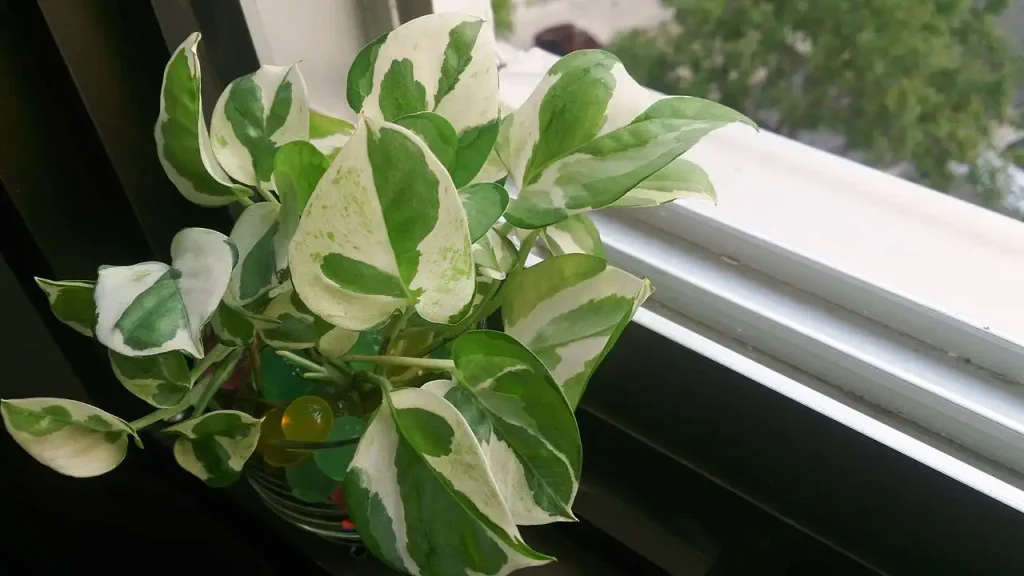
Here are some benefits of Manjula Pothos:
Manjula Pothos, a stunning variety of the popular Pothos plant, offers several benefits, making it a favorite among plant enthusiasts. Here are some key benefits of Manjula Pothos:
- Air Purification:
- Manjula Pothos is known for its ability to purify indoor air. It can remove toxins like formaldehyde, benzene, and xylene, contributing to a healthier living environment.
- Low Maintenance:
- This plant is easy to care for, making it ideal for beginners. It thrives in low to medium light conditions and can tolerate occasional neglect, such as infrequent watering.
- Aesthetic Appeal:
- With its heart-shaped leaves adorned with striking variegation in shades of white, cream, and green, Manjula Pothos adds a touch of elegance and beauty to any space.
- Versatile Placement:
- Manjula Pothos can be grown in various settings, including hanging baskets, pots, and as a climbing vine. Its versatility allows it to fit into different interior designs and spaces.
- Improves Humidity:
- Like other houseplants, Manjula Pothos releases moisture into the air through transpiration, helping to increase indoor humidity levels. This can be beneficial, especially in dry climates or during winter when indoor air tends to be dry.
- Stress Reduction:
- Keeping houseplants like Manjula Pothos has been shown to reduce stress levels and improve overall mental well-being. The presence of greenery can create a calming and relaxing atmosphere.
- Propagation:
- Manjula Pothos is easy to propagate, making it a cost-effective way to expand your plant collection or share with friends. Simply take stem cuttings and root them in water or soil.
- Pest Resistance:
- This variety of Pothos is generally resistant to pests and diseases, making it a robust and resilient houseplant choice.
Incorporating Manjula Pothos into your home or office can enhance the aesthetic appeal, improve air quality, and contribute to a more relaxed and pleasant environment.

